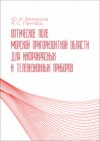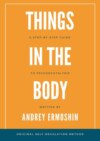Czytaj książkę: «Learn Languages Easily. Methods of self-regulation for successful learning»
Translator Maria Sapozhnikova
Translator Elena Lysenko
Editor Mary Larry
Editor William Schultz
Cover designer Maria Ermoshina
Illustrator Daria Ermoshina
© Andrey Ermoshin, 2018
© Maria Sapozhnikova, translation, 2018
© Elena Lysenko, translation, 2018
© Maria Ermoshina, cover design, 2018
© Daria Ermoshina, illustrations, 2018
ISBN 978-5-4490-1806-9
Created with Ridero smart publishing system
To the English-speaking Readers
This book is an introduction to psychotherapy and self-regulation methods without offering a person to admit that he or she is sick.
This book will help you learn foreign languages and turn this process into an easy and pleasant adventure. I also expect this book to do a bit more than that: the solution to the problem might also serve as an entrance to the world of self-regulation, the way you can maintain your health and pave your way to success.
Having begun to solve a specific problem, to study a language, in particular, a person understands that most of the obstacles to success in learning are inside.
The accumulated stress in the nervous system and the undeveloped pathways for perception of information can prevent him or her from getting new knowledge and forming new skills.
The stress is associated with the injuries, such as disappointment, deception, injustice, betrayal, unkindness, fear, etc. It can be also caused by stagnant strains, which have been formed during important periods of life: entering pre-school institutions or school, moving to another place of residence, changing job and other difficult situations. These are trace mobilization contours. All of them can be worked out, up to the most severe phobias.
Another important aspect of working with yourself is to pave a path for the new knowledge in the space of your consciousness…
The language is taken as a model. Any other task can be in that place, for example, the mastery of painting or the achievement of success in business. The algorithms for inner work, suggested in this book, can be used by any person and within any field of activity. Especially it can be useful for all teachers and students.
Thanks to the psychocatalysis practices, the readers will quickly restore their integrity and balance, supplement the competence and, by the end of the work, it will turn out that they have also learned the language, doing it easily, as if imperceptibly for themselves. What is more, the self-regulation skills will become even greater acquisition for the users of the method of psychocatalysis.
This is the second of my books, translated into English. The first one is “Phobias”. It describes the work with mental traumas. In Russian there are also the books “The Objects in the Body: psychotherapeutic method of work with sensations”, “Geometry of the Experiences: a constructive drawing of a person in psychotherapeutic practice,” “The Enigmatic Syndrome: panic attacks and how to treat them”, which describe other details of the methodology.
Originally, this book was addressed to the Russian-speaking readers. In Russia, people are willing to learn foreign languages, so this topic was taken as an example of the task, which is solved by many. In other countries, there may be other preferences, but I am sure that everyone will find useful the techniques of self-regulation offered in this book.
During reading and practicing you will learn a lot about yourself, grow up psychologically and you can be even healed.
Psychocatalysis offers the effective methods of improving your attention, motivation, ability to perceive the required knowledge, and other aspects of your personal achievements.
I wish you success in your self-regulation practices. This will be not only the contribution to your successful studying, but also an important factor of your personal growth and wellbeing.
Andrey Ermoshin
INTRODUCTION
How did this method appear?
“The head like a stone and the wooden feet’
“There’s no rush, but you’ve got to learn Chinese by the morning!” I think that sounds like a familiar situation not only to military interpreters who often use this phrase. Most of us live in a constant rush. We never have enough time to learn a foreign language although we urgently need it.
Some time ago, the author of the book found himself in the same situation. Fortunately, he managed to resolve it successfully, but it was not easy.
My head is ‘splitting’
At the end of 1992, I received a very interesting invitation to Italy for a course. The organizers paid all expenses, but there was one condition: I had to speak Italian, as there would be no interpreter1. The course was to begin in three months.
A group of about 10 people willing to go was organized. We found a very good teacher of Italian and plunged into the learning process. However, two weeks later, I started experiencing some unpleasant symptoms: I was having splitting headaches, my cheeks were burning, and my feet would get cold. When I shared this with my colleagues, it turned out that they were not doing great too: some were having headaches, and one of us even had a hypertonic crisis.

Fig. 1. An old TV with a big box and long thin legs. This is the way a person usually feels in a situation of information
overload: a hot heavy head of immense size and cold ‘shrunken’ wooden feet.
Later, when I began investigating this question, I found out that this problem is rather frequent: people of different age told me about similar symptoms in the situations when there was some information overload.
One patient described what he was experiencing in the following way: “My head was like a big old TV set, and the rest of my body was like those thin long legs TV sets used to have.”
Another patient of mine worked as a manager for one company, and this is what she was experiencing after one training course: “My head feels like a computer monitor, and as if there is a floppy disc stuck at the back of my neck. My legs are wooden2.”
Here is a story told by one of the participants. He is a pilot, and this is what he went through in the flight school.
The 17th class syndrome
There are about 680 English terms, which every pilot has to know. In reality, they use only 50 more or less, but they have to know all of them. Flight school is intense with six hours of English classes daily. By the time students reach class number seventeen, they find nothing better than to start drinking vodka. This is what they call “the syndrome of the seventeenth class’3.
Even little children can suffer from the syndrome of brain overload. “My head is filled with stones, and I cannot think straight,” – this is what pupils at school often say. Could it be the reason why they end up skipping classes?
There has to be a reasonable solution!
Alcohol is the worst solution to this problem: ethanol not only removes the information, but it also affects the hardware, so to speak. Running away from the studies does not help either: after some time, everything you have missed catches up with you. If you do not exercise today, you might miss out something significant tomorrow.
How can one avoid difficulties in the learning process and protect oneself from the disappointment in the future?
Learn with your heart
Here is how my story continued. The third class of Italian turned out to be the last one for us as a group. One of the participants said with a sad voice: “We’re learning the language with our brain, but what we have to do is to learn it with our heart”, and he put his hand on his chest.
On the way home, while sitting in a train, I thought, if there, in fact, was a language that we learned with our hearts. “It is our mother tongue!” There was an immediate answer to it. There was another step to make to have a discovery on our hands: “Where are my sensations connected with the Russian language?”
At that time, I was already working as a therapist and was deeply involved in the research of the methodology that would pay very close attention to the sensations experienced by the body. Our internal sight perceives these sensations as “objects inside our body.” This is exactly how I called the book devoted to the idea of psychocatalysis4.
Move that mass from the forehead to your body
As I closed my eyes, I was surprised to find out that my Russian language was ‘located’ somewhere at the level of the stomach. My inner vision registered it as a red-coloured ball that spread beyond the contours of my body. However, Italian triggered an absolutely different set of sensations. It was like a “white mass’ which was bursting my forehead. I dwelled on this sensation for some time and let the mass flow down where my Russian was. This moment was the beginning of my experiment.
As soon as Italian found its way to my stomach, my learning process gained speed, and I began soaking information like a sponge.
“Hatching’ on the train
Further processes might seem a bit surreal. That white mass, which poured down from my forehead to the stomach (my initial knowledge of Italian), turned into a clutch of eggs. Soon, the first nestling hatched. It looked like a little rooster. It fed on the words and expressions in Italian, and it grew very quickly. Turning to a new word only once was enough for the nestling to “swallow’ it.
The only time I could ‘devote’ to my nestlings was on the train on my way to work and back home. Local trains can be rather crowded, so quite often I could not find a place to sit. This made me more of a penguin rather than any other bird. So, I was making my way through the textbook by myself 16 minutes on the way to the city, and then 16 more minutes on the way back, five days a week.
My head is resting
The dates of my new linguistic trip moved to July instead of February, and that way, I got enough time to make my way through all 47 lessons of the textbook without any hurry.
In Italy, I was surprised to find out that my head remained calm and clear in response to the flow of Italian speech, and my stomach was “moving.” Approximately three days later, this movement in the area of my solar plexus calmed down, and Italian speech became clear, word for word, or as they say in Italian: “parola a parola’. My stomach felt slightly “disturbed’ as a person with an unusual speech appeared; for example, for a different professional sphere or with a different dialect. At some point, I realized that I had developed the same attitude towards Spanish too, as if it was a variety of Italian. I was merely trying to comprehend it in a very hands-on style, without any barrier. I think, this is the way children perceive any language. After some time, French speech also became quite interesting to my ear, as another variation of familiar Italian sounds.
What usually happens to our knowledge?
I have overcome my personal challenge successfully, as I managed to learn Italian and have been comfortable using it since then. I did the same with English. Nevertheless, what is also important for me in this experiment is the fact that the solution which I found to learn a foreign language can be used as an efficient model for a further research of how a person interacts with any kind of knowledge in general. Here are some questions that came up throughout the elaboration of the methodology.
– How can one make one’s body more responsive to the new information: how can one ‘soften’ it, if the body feels ‘rigid’, in order to open it up and welcome new information? How can one cultivate full engagement into the process of learning? How can one avoid neuroticism in the learning process?
– How is the overall competence developed? How do nature, culture, and the spirit mysteriously interact within one person? Is it, at all, possible to renew one’s perception?
– Are there ways to restore one’s contact with the knowledge, which we have inside, but which is somehow unavailable for immediate use? Is it possible to “plug in’ to universal knowledge, which is present in space? What do we get from our tradition by way of belonging to a family, people, and life in general?
I was gradually discovering the answers: they did not all come to me in one day, more as they were slowly falling into their place like pieces of a big puzzle. Behind simple algorithms, which you will find in this book, there are thousands of hours of individual psychotherapeutic sessions with my patients, hundreds of hours of group sessions with my students, and multiple episodes of self-observation in order to prove and grow those seeds of the new knowledge, that I discovered on the train after that memorable class of Italian.
Methods of self-development, that I would like to offer you in this book, might become useful for knowledge acquisition in any sphere. It can be professional development, sports, business, politics, and culture. Psychocatalysis is a universal method of self-regulation that will help you successfully achieve your life goals.
My personal experience of using this method has been exclusively positive so far.
Be inspired by a wonderful perspective!
Fruit of labour is sweet
The Italian language, as well as English which I learned, further along, have presented me with an opportunity to experience a variety of positive moments in my life. Being the only interpreter during some seminars and congresses, I would often work for hours, as if I had absolutely no idea how ‘difficult’ it was. When I was told that simultaneous interpreters are supposed to get some rest every 20—30 minutes, I was a bit confused: I must be the wrong kind of an interpreter, as I did not feel tired at all. It is highly likely that my own innocence saved me because it did not even occur to me that it could have been done differently.
I managed to save a lot of energy because the process of interpreting taught me to be calm and tune into the frequency of the speaker. It was about catching the ideas, not words, and looking at this process as an interesting game. At some point, I started enjoying finishing my translation before the speakers would finish expressing their thoughts. Other interpreters confirmed that such a tendency existed in their field. Interpretation is not just a kind of sports, it is also a school of artistry, and it is a highly interesting task!
I need to note that some of my fellow psychotherapists whom I have happened to work with and interpret are very peculiar people. Motto of one of the colleagues is “Sono tutti matti” (“We are all crazy!”), and then she would always add: “Ma sono capo dei matti!” (“But I am the head of all crazy!”). One can hardly fear anything else, having interpreted this lady.
I have conducted my seminars on psychocatalysis in Switzerland and Italy in Italian, including Sapienza University in Rome. I have invited my Italian-speaking colleagues to Russia on various occasions; there have been many situations where knowing Italian proved to be necessary and useful.
I have translated into Russian the book written by an Italian philosopher and psychotherapist, Antonio Mercurio. It was published in Russia in 2006. Here is its title: “Existential Anthropology and Personalistic Metapsychology”. I do not always remember the exact title right away. However, I feel proud that everything worked out.
Knowing the language has given me an opportunity to discover new cities and countries, as well as meet wonderful people. Memories of each of these meetings are still vibrant. I hope you will also have your victories and achievements, thanks to free communication without any language barrier: there will be people and new places, interesting projects in the countries that will open up in a new light because you speak their language.
Further on, I will share multiple episodes of how self-regulation methods can be used in everyday life – in psychotherapy, or while travelling, or in other situations. However, to overcome these intense moments in our lives, when maximum self-realization is expected from us, we need to learn to move from the state of tension and feeling ‘petrified’ to the state of freedom and flexibility.
In the next chapter, you will find information on how you can become more successful in the learning process, and what your possible stumbling points might be. I hope that you will be able to define your priority tasks with the help of self-diagnostics offered below.
Learning a foreign language can become a model for acquiring knowledge in any other sphere. If there’s a person who needs to make quick progress in any other field, the following algorithms can be easily adjusted to suit this goal.
Basic problems one encounters when learning a foreign language
New facts
There were times when it was more than enough to speak our mother tongue. Back then, life was revolving within the limits of the village or a region, where you travelled on a horse on the days of a fair, and in those circumstances, learning a foreign language seemed at least eccentric. Using a foreign language made sense only when a person was wealthy enough and had enough free time to subscribe to foreign magazines, or to travel, or if one had business abroad. Even a hundred years ago, there were very few people who could afford it.
Now, everything has changed. Knowing a foreign language is indispensable. Many people travel around the world as tourists; many also run international businesses; now, it is quite usual to have friends in foreign countries and on different continents. Modern technology and means of transportation make it all possible!
There is no limit to increasing our scope of knowledge. One should at least speak English, which is the language of international communication. It is recommendable to speak another foreign language, depending on your interests.
What do modern people think about education?
Let’s be honest; they do not always have a positive attitude towards this process. Learning a foreign language is often associated with hard work, extra effort, similar to climbing a mountain covered with ice, as there is always the danger of sliding back. Of course, we will do everything we can to hold tight and to keep on moving; we try to flatten our way to the top, to make it comfortable and easy, but before setting off on this journey, let’s define where we stand.
We will have a look at the cases when people were ‘lucky’ to avoid any difficulties, and everything simply worked out on its own. The examples of the “lucky ones’ can actually give us clues on how we can be successful, too! We will also turn to what causes difficulties in the learning process.
“I would learn English simply because…”
The lucky ones are those who learn the language of their favourite musicians, poets, and scientists. No one has to make these people study because, for them, it is a pleasure.
Schwarzenegger and Paul McCartney
One doctor, a colleague of mine, looks like Arnold Schwarzenegger, although he is of delicate psyche; he learnt German and Italian simply because these were the languages of Mozart, his favourite composer. He worked at a clinic, and he sometimes would donate blood to provide for his family, but during the nights, he was compiling a catalogue of all works composed by Mozart. Such hobby required the knowledge of the language, and that is why he learnt German and Italian.
Oleg, another friend of mine, is a musician. He looks a bit like Paul McCartney, and he adores “The Beatles”. For this reason, he learnt all their songs, and that is how he learnt English.
During the process of learning, such people usually make wonderful discoveries about the object of their interest, and that is what maintains their motivation.
There are countless stories about how quickly people learn the language when they fall in love with the foreigners! We can feel motivated in learning a language when we want to speak to a spiritual guru. The sole idea of meeting someone special, a person who triggers the surge of endorphins in your body (these are the hormones of happiness), filled with positive emotions and does not require any additional reward.
Those were the cases when everything was all right with the motivation, and that is exactly what helped to cross the boundaries.
However, it is quite possible to achieve success even when your motivation is not that highly emotional. There are also cases like that!













